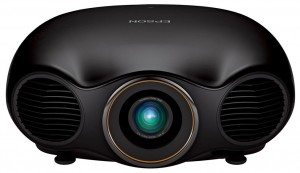Reviewing projectors that are 4K and HDR capable creates a new world for us reviewers, because 4K HDR changes a lot of things, and therefore, I find myself explaining, and clarifying a lot, since most of you aren't yet familiar, and because 4K with HDR still isn't "settled science."
The basics - again: The Epson LS10500 is a 1500 lumen projector that exceeds its brightness claims, buy a good amount. More to the point, it can top 1000 lumens fully calibrated. And that's healthy. The LS10500 does normal 1080 and 720 resolution (and any lower standards), but it also accepts 4K content, with High Dynamic Range.

The Epson LS10500 earns a Hot Product Award for its combination of great color and black levels with 4K/HDR content handling.
But also of major note, the Epson LS10500 uses a laser engine, so it will hold color accurately for essentially years, instead of months as a lamp based projector would shift color much faster. Also it will hold brightness, taking for most of us probably several years before it's dimmed 20%. With a lamp based projector, again, dimming starts immediately, but much faster, so that at full power, most of the competition is down around 25% brightness in the first 2000 hours.
Lasers and such stuff are all fun - and practical, but ultimately it's about the picture.
I've watched a lot of content on the LS10500, since it arrived a a few weeks ago, certainly pushing past 50 hours. During that same time period I watched a little on the Epson 5040UB I have here all year, so I can use it as a benchmark for all other projectors. I also had Sony's new $25K true 4K projector, here for the past 5 days, which made for some interesting comparisons.
For some reason, the LS10500 picture modes, right out of the box aren't as accurate as on the older LS10000. Also of note, the most accurate one (out of the box) on the older Epson was THX mode, which this projector does not offer. THX modes, I've found in the past, are usually pretty good, but not so good that a good calibration wouldn't make for a notable difference (and improvement).

This is our top regular award for projectors. In addition we offer additional awards in our special reports
But post calibration the numbers on the Epson LS10500 are about as dead on the money as one could hope for.
Skin tones (post calibration) are excellent, about as good as it gets, and the calibration measurements attest to that.
Expect a beautiful picture, whether daytime scenes or dark scenes, or anywhere in the middle. And thanks to great black levels (a real step up from Epson's UB models, plus the true black frame capability.
So, first item of order: If you decide to go with the LS10500 as your next projector (a pretty darn good choice), I would suggest that you have it calibrated. Or, not quite as good, try our settings published in our calibration pages. For the advanced calibration page - you need to be a subscriber, but hey, if you can afford an $8000 projector, you can afford an annual $3.99 to have it looking a lot better, and that's hundreds less than a calibrator would cost you.
For those of you who skipped all the middle pages of this (pretty darn) long review, the basics again:
Brightness - this is a 1500 lumen projector that tops 1000 lumens in best mode (post calibration). That makes it great for large screens - for standard 720 and 1080 content. For that normal content, or your laptop, iPhone, etc., 1000 lumens is enough for as large as a typical 150 inch diagonal screen (so no problem at all, on my own 124").
We set up our LS10500 so that we use Cinema for normal 2D content, and Digital Cinema for 4K content (including HDR).
But, we also did what we call a "quick cal" of Dynamic, the brightest mode. Like the brightest on most projectors - it had heavy greens and yellows out of the box. The goal was to create a mode that still looked pretty darn good, but more able to cut through ambient light than the precisely calibrated other two modes. That "tuned" but not fully calibrated Dynamic provides an extra couple hundred plus lumens compared to the other two modes.
Reviewing projectors that are 4K and HDR capable creates a new world for us reviewers, because 4K HDR changes a lot of things, and therefore, I find myself explaining, and clarifying a lot, since most of you aren't yet familiar, and because 4K with HDR still isn't "settled science."
The basics - again: The Epson LS10500 is a 1500 lumen projector that exceeds its brightness claims, buy a good amount. More to the point, it can top 1000 lumens fully calibrated. And that's healthy. The LS10500 does normal 1080 and 720 resolution (and any lower standards), but it also accepts 4K content, with High Dynamic Range.

The Epson LS10500 earns a Hot Product Award for its combination of great color and black levels with 4K/HDR content handling.
But also of major note, the Epson LS10500 uses a laser engine, so it will hold color accurately for essentially years, instead of months as a lamp based projector would shift color much faster. Also it will hold brightness, taking for most of us probably several years before it's dimmed 20%. With a lamp based projector, again, dimming starts immediately, but much faster, so that at full power, most of the competition is down around 25% brightness in the first 2000 hours.
Lasers and such stuff are all fun - and practical, but ultimately it's about the picture.
I've watched a lot of content on the LS10500, since it arrived a a few weeks ago, certainly pushing past 50 hours. During that same time period I watched a little on the Epson 5040UB I have here all year, so I can use it as a benchmark for all other projectors. I also had Sony's new $25K true 4K projector, here for the past 5 days, which made for some interesting comparisons.
For some reason, the LS10500 picture modes, right out of the box aren't as accurate as on the older LS10000. Also of note, the most accurate one (out of the box) on the older Epson was THX mode, which this projector does not offer. THX modes, I've found in the past, are usually pretty good, but not so good that a good calibration wouldn't make for a notable difference (and improvement).

This is our top regular award for projectors. In addition we offer additional awards in our special reports
But post calibration the numbers on the Epson LS10500 are about as dead on the money as one could hope for.
Skin tones (post calibration) are excellent, about as good as it gets, and the calibration measurements attest to that.
Expect a beautiful picture, whether daytime scenes or dark scenes, or anywhere in the middle. And thanks to great black levels (a real step up from Epson's UB models, plus the true black frame capability.
So, first item of order: If you decide to go with the LS10500 as your next projector (a pretty darn good choice), I would suggest that you have it calibrated. Or, not quite as good, try our settings published in our calibration pages. For the advanced calibration page - you need to be a subscriber, but hey, if you can afford an $8000 projector, you can afford an annual $3.99 to have it looking a lot better, and that's hundreds less than a calibrator would cost you.
For those of you who skipped all the middle pages of this (pretty darn) long review, the basics again:
Brightness - this is a 1500 lumen projector that tops 1000 lumens in best mode (post calibration). That makes it great for large screens - for standard 720 and 1080 content. For that normal content, or your laptop, iPhone, etc., 1000 lumens is enough for as large as a typical 150 inch diagonal screen (so no problem at all, on my own 124").
We set up our LS10500 so that we use Cinema for normal 2D content, and Digital Cinema for 4K content (including HDR).
But, we also did what we call a "quick cal" of Dynamic, the brightest mode. Like the brightest on most projectors - it had heavy greens and yellows out of the box. The goal was to create a mode that still looked pretty darn good, but more able to cut through ambient light than the precisely calibrated other two modes. That "tuned" but not fully calibrated Dynamic provides an extra couple hundred plus lumens compared to the other two modes.



